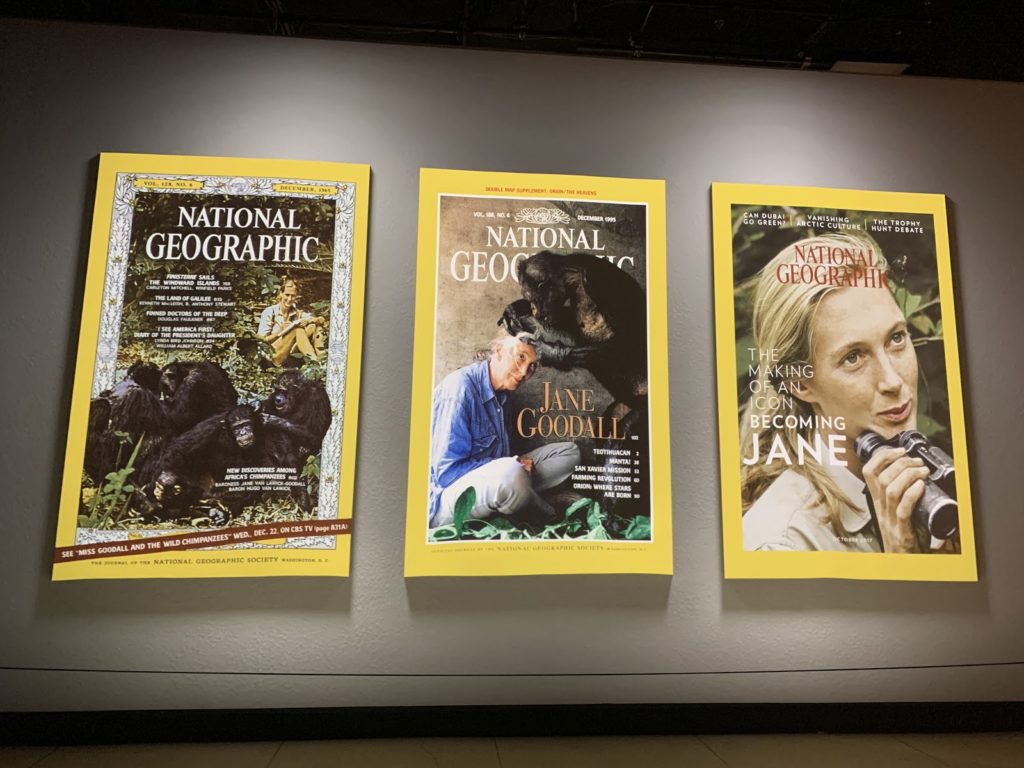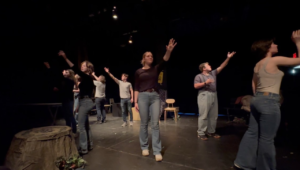Jane Goodall: National Geographic Covergirl, Worldwide Phenomena

Image courtesy of Julianna Guthrie
By Julianna Guthrie
Becoming Jane: The Evolution of Dr. Jane Goodall is a new innovative exhibit put out by the National Geographic Museum in partnership with the Jane Goodall Institute. The exhibit opened last November and will remain open through the summer of 2020.
Visitors are led into the exhibit by a member of the National Geographic Museum staff who directs their attention to a screen with three images of National Geographic Magazines covers on which Goodall has appeared. Visitors begin by watching a short video narrated by the doctor speaking briefly on her lifelong passion and work.
The exhibit’s walkthrough begins by looking through little remnants of Goodall’s childhood, where her infatuation with wildlife began. She credits a plush monkey, which was given to her by her parents, despite being warned by friends that it would scare her, as being her most prized companion and possession.
Goodall’s early work included observing hens laying eggs in her yard. She also kept a journal where she recorded her findings with both drawings and vivid descriptions. Goodall also read Tarzan and Dr. Dolittle.
Visitors are ushered from her primitive years to her university and early-adult years. Her desire to go and study in Africa continually grew stronger despite the hardship. Her first trip to Africa was visiting a friend who had just obtained a farm in Kenya. It was during this time that she was acquainted with and later became secretary to Dr. Louis Leaky.
After working for Leaky, she was offered an opportunity to study chimpanzees in Gombe, Nigeria in place of Leaky. Although she faced many challenges, such as funding and navigating hostile territories, she eventually arrived in Gombe with her mother to begin her research.
Visitors are able to walk through a make-shift tent filled with only the absolute necessities that accompanied Goodall on her trip. These included medicine, food, notepads, and paper. Only after being in Gombe for some time was she able to procure herself a typewriter.
At the end of the tented area, there is another film. This film, also narrated by Goodall, allows visitors to dive deeper into both the psychology of Goodall and the chimps. The visitor is able to really understand how personal this experience was for her as she equates the chimps to humans, noting that they express emotion and have individual personalities.
There is a small area dedicated to the National Geographic photographer Hugo Van Lawick, who worked briefly under Leaky and was later ordered to photograph Goodall while she worked.
From there, visitors are ushered into a circular 3-D Standing Theater. The screen draws from the walls all the way down to the floor. As visitors are completely surrounded by the African forest, they witness the chimpanzees’ behaviors with their own eyes and work side by side with Jane as she studies the fascinating species.
After visitors exit the theater they are able to read all of the groundbreaking research and discoveries made by Goodall throughout the years. Visitors are not able to only learn about chimpanzees, but they are able to learn about them the way Goodall did. There is a screen that makes her research notes and drawings come to life and booths where visitors can learn different chimpanzee calls and imitate them for themselves. The highlight of this part of the exhibit is the large screen visitors approach towards the end of the exhibit. Visitors can grab a set of binoculars and choose with their movements what area of chimpanzee behavior they want to study. As visitors look through the forest and observe the chimps, the type of behavior is being narrated to them.
Visitors end their chimpanzee “research” by learning about the dangers chimpanzees face today, such as wire snares, biomedical research, and extinction. Visitors are also able to read about the steps Goodall has taken in order to protect the chimpanzees.
“It’s always inspiring for me to find out about women that despite boundaries of sexism have been out in the world doing research and looking for ways to help nature and our planet,” said Holly Thompson, president of the CUA Environmental Club.
If you are interested in doing more nature-oriented work, you have the opportunity to get involved on campus.
“Our organization has a lot of opportunities for people to learn about different topics involving the environment,” said Thompson. “Every other Friday this semester, we will be tabling to talk about different issues. We will have some snacks and posters about the issue and people will be able to stop by and learn about it. “
If you would like to discover Dr. Goodall’s work for yourself, the museum is located at 17th and M Street NW, and its hours run from 10 AM to 6 PM daily. Tickets are $12 for students.







